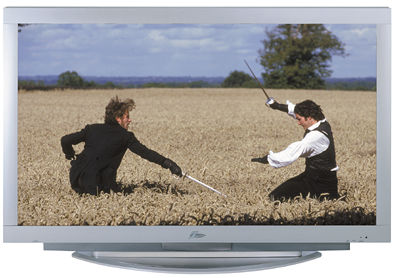Zenith P60W26P High-Definition plasma monitor

Now comes the second generation of that display, the P60W26P, and one significant improvement is immediately evident even before you plug it in: the price. The P60W26P costs $14,999—a 40% drop in price from the DPD60W, which cost $24,999 just a year ago. What's more, the new model outperforms the older one in several important respects.
Description
Like most plasma displays, the P60W26P is a monitor: a widescreen, 16:9 model in a broad silver frame. Without an external tuner, it won't even display conventional television; most people will simply use a VCR as an NTSC tuner. Of course, this model can also display HDTV, for which you need an external DTV tuner. Its resolution is 1280x720, which corresponds to ABC's high-definition broadcasts at 720p. The more common 1080i broadcasts are converted to 720p (that is, 1280x720) by the P60W26P's internal Sage scaler. The older DPD60W was advertised as offering a maximum resolution of 1280x720, but Zenith admitted that it was actually capable of 1366x768. They make no such claim for the P60W26P.
For all the power of the statement this plasma will make in your room, it's a rather simple device, as a monitor should be. It has few features and options. There is, of course, aspect-ratio control, though it's minimal: 16:9, 4:3, and Stretch, which simply magnifies and crops an image to fill the screen. Other products offer a wider range of aspect-ratio options.
Like every plasma we know of without an outboard control box, the P60W26P lacks an onboard tuner and offers a bare-bones array of inputs: one for each of the normal analog inputs, including component and RGB, which means you can use the monitor as a computer display. It has none of the new digital inputs, such as DVI or FireWire. And with just one component input, you won't be able to hook up both a digital tuner and a DVD player using component connections unless you have an outboard switching box. That's normal for plasmas; they lack the rear real estate to accommodate lots of inputs. Still, some plasmas—notably Pioneer's latest 50-inch model, the PDP-5030HD—offer outboard control boxes that provide a plethora of inputs. But that would have added to the Zenith's price, which has been kept admirably low.
If you connect at least two video sources, such as two external tuners, DVD player, etc., the P60W26P offers picture-in-picture and twin picture (two equal-sized images side by side) display options. There's also a freeze-frame function, activated from the remote.
There are only two picture-setting memory locations: one for the RGB input and one for all other inputs. That's a shame. DVDs, VCRs, and, particularly, HDTV usually require different picture settings for each input.
Zenith sells optional speakers for the set, designed to connect to either side of the screen by means of friction-clamps. My review sample came without speakers, which was no problem; I assume that almost anyone paying this much for a TV will have a dedicated home-theater audio system. The remote is not backlit, but it is well-designed and easy to use.
All of the P60W26P's features are similar if not identical to those on the DPD60W. Where they differed was in performance.
Performance
The DPD60W was noisy—and I don't mean video noise. It had a loud fan. The new P60W26P was quiet—no fan noise. The older display looked terrible when I first turned it on, with a blue, grainy picture. The P60W26P's picture looked pretty good at first glance. But then, the DPD60W had come with its Contrast control cranked up to 100. The P60W26P's Contrast was set near 50%. It was obvious that my P60W26P had been used before, and adjusted at least to some extent. (Batteries were already loaded in the remote!) In any case, the P60W26P looked pretty good right out of the box.
The biggest issue with the DPD60W had been a tendency to temporary screen burn-in, visible primarily from test patterns. If a light-colored pattern was held on the DPD60W's screen longer than average scenes in normal program material, the image was still visible even a minute or two later during dark scenes. It faded away eventually, but that could take several minutes.
The P60W26P reduced but did not eliminate this problem. Once, after holding the Color and Tint test pattern from Video Essentials on the screen for a couple of minutes to make adjustments, I saw the words Color and Tint lingering on the screen when, a few minutes later, I looked at a dark test pattern. Within a few minutes, these images faded away.













































